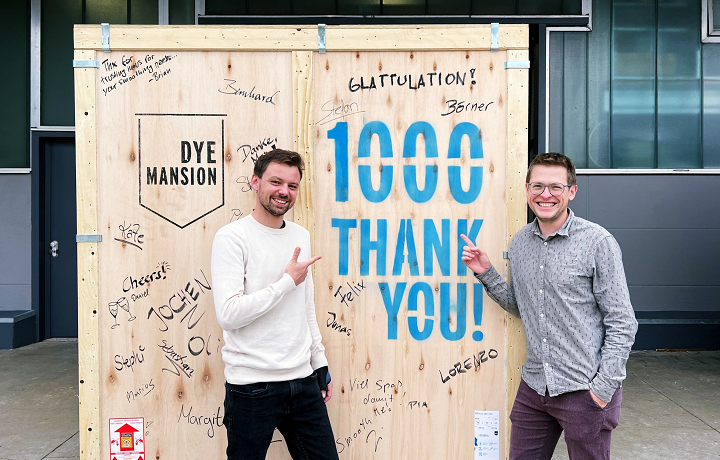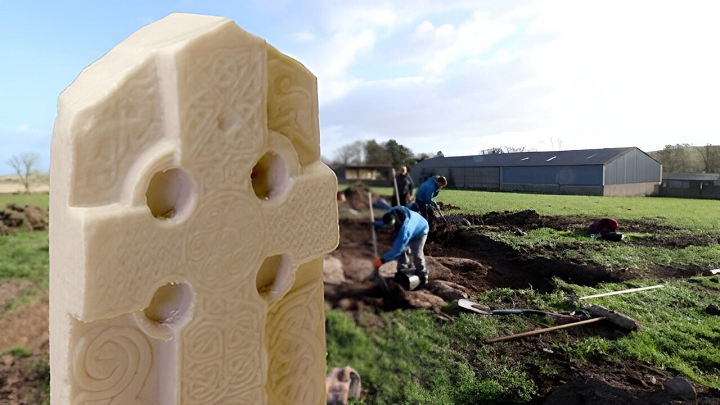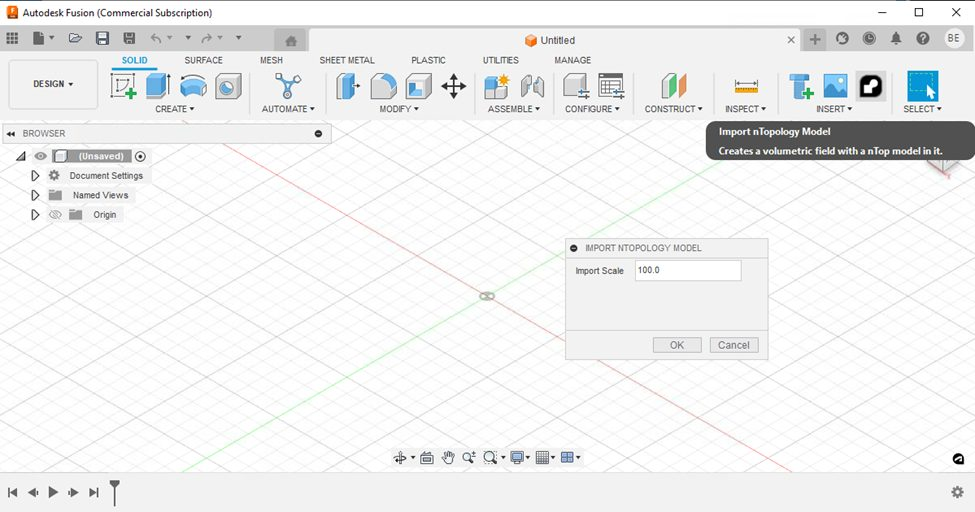In 3D Printing News Briefs, we’re sharing stories about business first, as DyeMansion reached a major milestone and Batch.Works launched an equity crowdfunding campaign. At formnext 2023, Wibu-Systems showcased its CodeMeter IP protection and licensing system, while nTop and Autodesk Fusion demonstrated their new implicit modeling integration. We’ll end with direct ink writing research inspired by Jackson Pollock, and archaeologists in Scotland are using 3D printing, 3D scanning, and other modern technologies to recreate artifacts to enhance teaching and public engagement.
DyeMansion Announces Major Sales Milestone

L-R: Founders Philipp Kramer (CTO) and Felix Ewald (CEO) in front of the 1000th machine, a Powerfuse S, before it was delivered to their customer ZEISS Vision Care
Industrial post-processing leader DyeMansion recently announced a major milestone: the sale of its 1,000th machine. The Germany-headquartered company, with a network of 34 global sales partners, has grown significantly since selling its first machine in 2016. It now has a team of 95 dedicated employees, offerings for integrated end-to-end post-processing workflows like surfacing, advanced depowdering, and coloring solutions, and has achieved an impressive Compound Annual Growth Rate (CAGR) of 38% over the last five years. As for its 1,000th machine, the advanced vapor smoothing Powerfuse S system was sold through German sales partner Solidpro—part of the Bechtle Group—to global ophthalmic industry leader ZEISS Vision Care, which provides instruments, lenses, and more to retailers, optometrists, and opticians in over 60 markets worldwide.
“We chose the Powerfuse S from DyeMansion because the system is perfectly tailored for finishing our 3D printed plastic parts,” said Andreas Dangelmaier, Head of Engineering Design at ZEISS Vision Care. “For use in our cleanroom environment, the surface quality requirements are extremely high. At the Aalen site, we additively develop and manufacture, among other things, tools and components for the production of individual precision eyeglass lenses. For this, Industry 4.0 capabilities, precision, and connectivity of the DyeMansion system are indispensable. Of course, we also particularly like the sustainability aspect due to the non-toxic and biodegradable polishing medium.”
Batch.Works Launches Equity Crowdfunding Campaign on Seedrs

Batch.Works’ agile manufacturing systems are transforming the way things are made to enable the circular economy. Pearson Lloyd’s bFRIENDS collection for Bene pictured.
For the past six years, agile manufacturing company Batch.Works has been on a mission to transform manufacturing with its circular capabilities, partnering with over 50 clients in med-tech, retail, furniture, and consumer electronics to 3D print over 150,000 parts from bio-sourced or recycled materials. The startup has received investments from leading clean-tech fund Sustainable Ventures, as well as £1.8M in government grant projects, and is ready to scale. It recently launched an equity crowdfunding campaign on the Seedrs platform, with the goal of speeding up its R&D of AI-driven smart factory systems, as well as preparing to launch its Circular Manufacturing as a Service (CMaaS). The Seedrs campaign, which is the company’s first public round of funding, offers 7.89% equity at Batch.Work’s pre-money valuation of £3.5m, and reached its target of £300,000 within 24 hours.
“This campaign is the first and last chance to invest in our company at its current valuation. Previous investments have been private, but we expect that many of you would like to join us as we develop our agile manufacturing systems designed to transform the way things are made and enable the circular economy. We hope this public campaign will make more people aware of our purpose, building a wider community around our business,” said Julien Vaissieres, the CEO and Founder of Batch.Works.
“Our smart technology and sustainable production methods are helping companies move faster, find success and reduce waste. We reduce the capital investment needed for traditional methods and reduce risk by providing flexible, on-demand manufacturing capabilities and extending product life cycles.”
Wibu-Systems Showcases CodeMeter Technology at formnext
Germany-based Wibu-Systems, a leader in cybersecurity and software license lifecycle management, attended the recent formnext 2023, and joined the VDMA association’s joint exhibit to showcase its CodeMeter technology, which unlocks business potential, licensing, and intellectual property (IP) protection in AM. To ensure a successful AM business, its systems must be secured on several fronts, especially with the constant risk of IP theft and piracy. CodeMeter has a proven ability to safeguard digital assets and strengthen enterprise results without increasing complexity or holding back commercial potential. The IP protection and licensing system was built around versatile license management and “unbeaten” encryption technology, and enables new license-driven business models.
Wibu-Systems’ CodeMeter is able to create virtual marketplaces, and its licenses are trustworthy enough to enable flexible, yet reliable distributed manufacturing. As an example, the company integrated CodeMeter in a novel online store service for Daimler and Setra brand bus parts and components. These means that operators of these buses are able to purchase 3D printable parts on the secure digital marketplace and have them printed on a certified Farsoon system—streamlining the entire process, so buses can get back to service quickly. CodeMeter uses one license to secure the preprint process, and another to authorize, trace, and invoice the purchased number of parts, which enables full security. Plus, its smart license management capabilities and easy integration with back office systems make the whole process very smooth.
Autodesk Fusion & nTop Join Forces for Direct Implicit Model Import
Speaking of showcasing solutions at formnext, Autodesk Fusion and nTop have joined forces to enable direct implicit model import, which was demonstrated at the Frankfurt trade show before the solution was actually released (this should happen in early 2024). Implicit modeling is a complementary tool to CAD software, enabling the creation of data-driven designs, repetitive structures, and more. nTop’s software is at the forefront of this technology, allowing users to automate processes and develop complex, high-performance parts, and Autodesk Fusion uses the technology in its Product Design Extension, so users can modify solid or mesh bodies to create complex volumetric lattices. Now, shared users can easily work with both software platforms, as designers using Fusion to create AM models can also use nTop’s implicit modeling capabilities with a new add-in.
This add-in has several advantages, including enhancing models for lightweighting and improved thermal management, and the seamless transition of nTop designs to Autodesk’s comprehensive CAD/CAM tools. The new implicit import feature renders large mesh files unnecessary, so nTop users can export their implicit designs and import them directly into Fusion in just seconds. Users can also incorporate Fusion’s build preparation capabilities—like part orientation, packing, slicing, and support generation—to improve AM process efficiency. The integration’s implicit import functionality also provides nTop users with a bridge to Fusion’s process simulation toolset, so they can access the software’s metal powder bed fusion process simulation capabilities, and Fusion’s CAM features allow for the manufacturing of nTop-designed parts with CNC machining as well. In a nutshell, this implicit modeling add-in makes it possible to easily manage design data during the whole process.
Direct Ink Writing with the Fluid Rope Trick
Scientists from Harvard University and MIT were inspired by abstract expressionist artist Jackson Pollock, who used a dripping technique that’s fascinated physicists for years. It’s like when honey coils in on itself when drizzled over a piece of toast—if a nozzle is too far from the printing substrate, this same phenomenon can happen. Instead of trying to control and suppress the underlying physics of coiling instabilities, the team used machine learning to teach 3D printers how to “write” with coiling fluid ropes. They used direct ink writing, and the team exploited coiling instabilities, using a class of machine learning algorithms called reinforcement learning. The researchers ran numerical simulations with several lab experiments, and dispersed a simple viscous fluid through a nozzle at a fixed flow rate, which deposited the fluid along a predefined path. They eventually graduated to drizzling chocolate syrup onto a texture wafer to spell out “Cambridge,” which demonstrates the viability of their approach.
“Here we use Deep Reinforcement Learning to derive control strategies for the motion of the extruding nozzle and thus the fluid patterns that are deposited on the surface. The method proceeds by having a learner (nozzle) repeatedly interact with the environment (a viscous filament simulator), and improves its strategy using the results of this experience. We demonstrate the outcome of the learned control instructions using experiments to manipulate a falling viscous jet and create cursive writing patterns and Pollockian paintings on substrates,” the researchers wrote in the abstract of their study.
Archaeologists Using 3D Printing & Scanning to Enhance Teaching

A copy of a Pictish carved stone created using photogrammetry and a 3D printer. Credit: University of Aberdeen
Archaeologists at the University of Aberdeen are improving teaching and public engagement of their discipline through the use of 3D printing, scanning, photogrammetry, and smartphone technology. According to Dr. James O’Driscoll, they’re using “Ra-Pict prototyping” to recreate all kinds of artifacts, from swords and bone combs to spearheads and symbol stones, so that people can physically touch the objects and engage with them, unlike the typical atmosphere in museums. They’re also able to make digital 3D models and physical copies of artifacts they find before they undergo potentially damaging testing, like radiocarbon dating. The archaeologists are also using some of the latest smartphone software for their work.
“Some of the newer iPhones have what’s called a LiDAR scanner in the back of them, and we can use that to shoot laser beams at whatever objects we want to scan and it’ll make a really detailed 3D model almost instantaneously,” Dr. O’Driscoll said.
“So, we’ve been using this technology at a variety of our excavations and also to make copies of carved stones and other artifacts that are now in museums. It gives us really detailed 3D models and a record of what we’ve excavated so it is really helping to speed up excavations and increase the accuracy of the data that we’re able to collect on site.”
Subscribe to Our Email Newsletter
Stay up-to-date on all the latest news from the 3D printing industry and receive information and offers from third party vendors.
Print Services
Upload your 3D Models and get them printed quickly and efficiently.
You May Also Like
Nikon SLM Solutions Sells SLM 500 to Primary Weapon Systems to Expand Suppressor Production
Primary Weapons Systems (PWS) is a Boise, Idaho-based manufacturer of suppressors, firearms, and related components. A subsidiary of Vigilant Gear and a sister company to aftermarket Glock slide manufacturer Lone...
3DPOD 261: Tooling and Cooling for AM with Jason Murphy, NXC MFG
Jason Murphy´s NXC MFG (Next Chapter Manufacturing) is not a generalist service; instead, the company specializes in making tooling. Using LPBF and binder jet, the company produces some of the...
HP and Firestorm Labs Form Partnership to Use Multi Jet Fusion 3D Printers in Deployable Factories
HP Inc., maker of a range of additive manufacturing (AM) solutions including the Multi Jet Fusion (MJF) ecosystem, has announced a partnership with Firestorm Labs, a developer of containerized, deployable...
3D Printing News Briefs, July 2, 2025: Copper Alloys, Defense Manufacturing, & More
We’re starting off with metals in today’s 3D Printing News Briefs, as Farsoon has unveiled a large-scale AM solution for copper alloys, and Meltio used its wire-laser metal solution to...



































